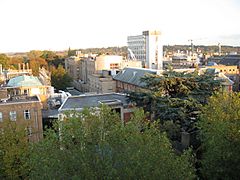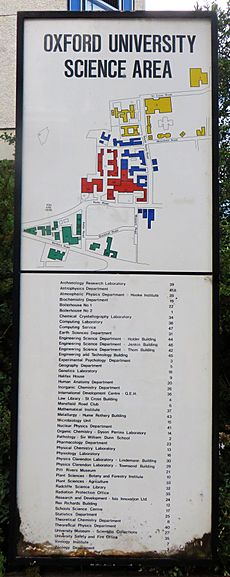Science Area, Oxford facts for kids
Quick facts for kids Science Area |
|
|---|---|
 Oxford Science Area |
|
| OS grid reference | SP515069 |
| Civil parish |
|
| District | |
| Shire county | |
| Region | |
| Country | England |
| Sovereign state | United Kingdom |
| Post town | Oxford |
| Postcode district | OX2 |
| Dialling code | 01865 |
| Police | Thames Valley |
| Fire | Oxfordshire |
| Ambulance | South Central |
| EU Parliament | South East England |
| UK Parliament |
|
| Website | Science Area, University of Oxford |
The Oxford University Science Area is a special part of Oxford, England. It's where most of the University of Oxford's science departments are found. Think of it as a big campus just for science!
Contents
Where is the Science Area?
The main part of the Science Area is in Oxford. It's south of the University Parks and north of South Parks Road. Parks Road is on its west side.
Some science departments are also found south of South Parks Road. There's another part of the Science Area nearby. This area is shaped like a triangle. It's called the Keble Road Triangle. It has Banbury Road to the west, Keble Road to the south, and Parks Road to the northeast.
History of Science at Oxford
The Oxford University Museum of Natural History opened in 1860 on Parks Road. Many science subjects started there. These included astronomy, chemistry, geology, and zoology.
As these departments grew, they needed more space. So, they moved to new buildings. These new buildings were built along South Parks Road.
The University is also developing a new area. It's called the Radcliffe Observatory Quarter. This area used to be a hospital. Now, it's being turned into new spaces for university departments. The plans for this new area were approved in 2009.
New Buildings and Updates
The new Biochemistry Building is one of the newer parts of the Science Area. It was designed by architects called Hawkins\Brown. Landscape architects also helped design the outdoor spaces. These spaces are for students, researchers, and staff to enjoy.
Science Departments at Oxford
Many different science subjects are studied here. Here are some of the departments:
- Biochemistry: This is where scientists study the chemistry of living things.
- Chemistry: This department explores what things are made of. It includes:
- Chemistry Research Laboratory
- Chemical Biology
- Inorganic Chemistry Laboratory
- Organic Chemistry
- Physical and Theoretical Chemistry Laboratory
- Computer Science: This department studies computers and how they work. It used to be called the Computing Laboratory. It includes:
- Numerical Analysis Group
- Programming Research Group
- Earth Sciences: Here, students learn about our planet, including rocks and landforms.
- Engineering Science: This department focuses on how to design and build things.
- E-Research Centre: This center helps with research using digital tools.
- Experimental Psychology: This department studies how people think and behave.
- Oxford University Centre for the Environment: This center focuses on environmental studies.
- Materials: Scientists here study different materials and their properties.
- Mathematical Institute: This is where students learn about numbers, shapes, and patterns.
- Pathology, Sir William Dunn School of: This school studies diseases and their causes.
- Pharmacology: This department studies how medicines affect the body.
- Physics: This department explores how the universe works. It includes:
- Astrophysics: The study of stars and galaxies.
- Atmospheric, Oceanic and Planetary Physics: The study of Earth's atmosphere, oceans, and other planets.
- Clarendon Laboratory:
- Atomic and Laser Physics
- Condensed Matter Physics
- Particle Physics: The study of tiny particles that make up everything.
- Theoretical Physics
- Physiology, Anatomy & Genetics: This department studies how living bodies work.
- Plant Sciences: This department focuses on plants and how they grow.
- Research Laboratory for Archaeology and History of Art: This lab uses science to study old objects and art.
- Zoology: This department studies animals.



